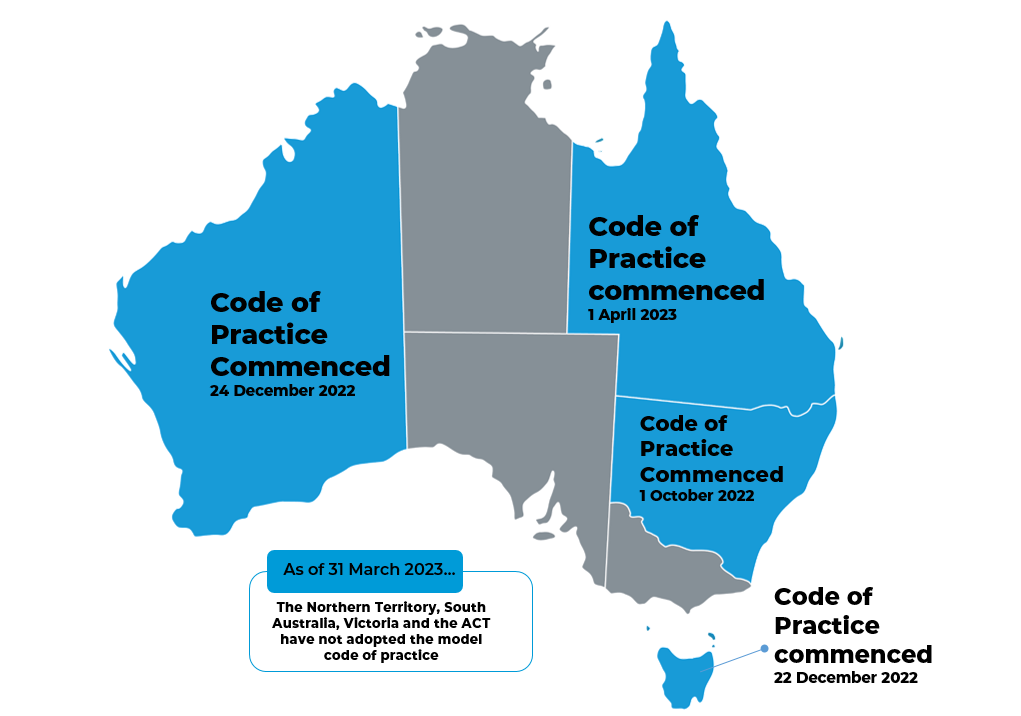04 April 2023
10 min read
Published by:

Safe Work Australia developed model Work Health and Safety laws (model WHS laws) in 2011, which most states (except Victoria) have now implemented with minor variations. The laws comprise of the model WHS Act, model WHS Regulations and model Codes of Practice.
With managing psychosocial hazards in the workplace being an important responsibility for all employers, especially human resources managers, it is essential for businesses to understand Australia’s existing health and safety law framework and key considerations when addressing these hazards at work.
In this three-part series, we look at various codes of practice in relation to psychosocial hazards in the workplace and how businesses can implement these into their operations. Our first instalment provides an overview of the relevant legislation and key considerations.
A review of the model WHS laws conducted between 2017 and 2018 (the Boland Review) identified that psychological health was neglected in the model WHS Regulations and the model Codes of Practice. Recommendations included additional regulations to be developed regarding methods in identifying psychosocial risks in the workplace and the appropriate control measures to manage those risks.
In July 2022, Safe Work Australia updated the model WHS Regulations to incorporate those recommendations in relation to psychosocial risks in the workplace. At the same time, Safe Work Australia also published the final version of a new model “Code of Practice: Managing psychosocial hazards at work”, providing practical guidance on how to identify, manage and control psychosocial hazards in the workplace.
Each Australian state has taken a different approach to the model Regulations and Code, requiring human resources managers to understand and apply different rules in each state a business operates in.
The model WHS Act defines “approved code of practice” as a code of practice approved under Part 14 of the model WHS Act. The relevant sections under Part 14 are sections 274 and 275. Section 274 of the model WHS Act confirms that a Minister may approve a code of practice for the purpose of the WHS Act and may vary or revoke an approved code of practice. Accordingly, when the model Code of Practice for psychosocial hazards was introduced, it was not automatically applicable to the states. The code of practice does not come into effect unless adopted and approved by the Minister in the relevant state. These definitions and concepts are reflected in the harmonised WHS Acts in the relevant states.
Section 276 of the Model WHS Act provides that the Governor in Council may make regulations under the WHS Act. A regulation may make provision for any of the matters listed in schedule 3 of the WHS Act (i.e. duties or hazards and risks) or otherwise related to work health and safety. Further, a regulation may:
The WHS Regulations are essentially a supporting legislative instrument that provides for specific requirements or information in respect to various elements initially raised by the WHS Act. For example, the legislation imposes a duty for employers to report notifiable incidents, such as the death of a person, serious injury or illness, or a dangerous incident. Serious injury or illness includes any other injury or illness prescribed under a regulation. The WHS Regulation also provides a list of conditions which are classed as a serious illness including, for example, Q fever and Anthrax.
Persons conducting a business or undertaking (PCBU) must ensure that they consult the WHS Regulations in order to ensure compliance with the WHS Act. If an approved code of practice exists, a PCBU must either comply with the code or manage hazards and risks arising from the work carried out as part of the conduct of the business or undertaking in a way that is different to the code, but provides a standard of health and safety that is equivalent to or higher than the standard required under the relevant code. The code of practice should be treated as the bare minimum requirements to comply with duties under the Act in respect to that specific issue covered by the code of practice.
There is interaction between the WHS Regulations and the code of practice for psychosocial hazards. As we know, the code requires PCBU’s to identify risks, assess the hazards and implement control measures. The WHS Regulations and the requirements are largely the same but businesses should ensure that they have reviewed both to ensure continuing compliance with both. Importantly, businesses must also remember that they are required to consider all risks associated with work, and not just those covered by a regulation or code of practice.
A key difference between the WHS Regulations and the code of practice is that an approved code of practice is designed to be a practical guidance tool to help meet the requirements of the WHS Act and WHS Regulation. Codes of practice are admissible in court proceedings and may be used as evidence of what is known about a particular hazard, risk or control. Further, the code may be relied upon in determining what is reasonably practicable in the circumstances for which the code relates to. This means that in turn, the code of practice may be relied upon to demonstrate a PCBU’s failure to meet and comply with their duties under the WHS Act.
As illustrated below, several jurisdictions have updated their WHS laws to incorporate the “Code of Practice: Managing psychosocial hazards at work”. Each state has started with the Safe Work Australia model Code of Practice and applied their own edits to the model Code. That means that while Safe Work Australia published a model Code of Practice to encourage consistency, human resources managers need to ensure they are accessing and applying the correct Code of Practice for their state, as the Codes implemented are not identical to one another and are not identical to the Safe Work Australia model Code of Practice.

Each of the states which have adopted the Code of Practice, have updated their version of the WHS Regulations to incorporate the new obligations. More specifically, the changes can be found in each of the following sections for each state:
The Codes of Practice are accessible from the links below:
Human resources managers should take into consideration several key factors in relation to psychosocial hazards in the workplace. These include:
In our next instalment, we take a closer look at the new Queensland Code of Practice for Managing Psychosocial Hazards in the Workplace and how implementing the code might look for your business.
If you have any questions about the regulations and codes of practice in the different states, please get in touch with a member of our national Workplace Relations & Safety team below.
Disclaimer
The information in this article is of a general nature and is not intended to address the circumstances of any particular individual or entity. Although we endeavour to provide accurate and timely information, we do not guarantee that the information in this article is accurate at the date it is received or that it will continue to be accurate in the future.
Published by: